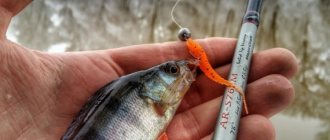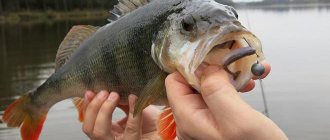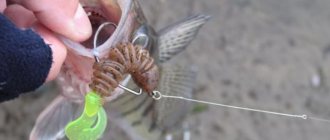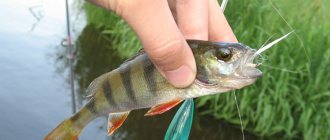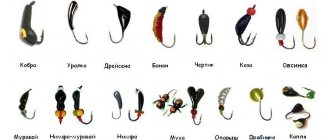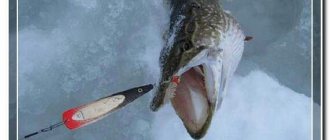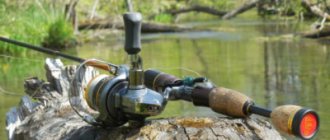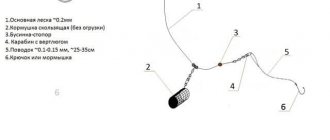Content
- Choosing microjigging gear
- Lures in microjig
- Microjig fishing technique
- Cord or fishing line?
- Where to fish with micro jig?
Friends, as you understand from the title of the article, today we want to talk about such a concept as microjig. For several years now, this type of fishing has been gaining great popularity due to its applicability on any body of water, regardless of its degree of pressure. At any time, be it before work in the morning or after work in the evening, we can always go out to the body of water closest to us and, using ultralight tackle, catch several fish that live in the coastal zone, while receiving a lot of emotions and pleasure. After all, good ultralight tackle allows us to truly fight even the smallest fish. But, closer to the point... Let's define what microjig is and quickly move on to the experts who answered all our questions.
So, microjig is a type of jig fishing in which we use the lightest heads and small baits. Most fishermen have conditionally determined that microjig fishing includes fishing with lures with a total weight of up to 5 grams.
Probably, many beginners in ultralight fishing, in particular microjig, have a lot of questions about choosing the right gear, lures, fishing technique, and so on. We asked our experts and this is what they told us.
Choosing microjigging gear
Grigory ( Grinya ) is an active fisherman, eminent user of the site, specialist in Aiko products:
Tell us about what parameters a good microjigging rod should have.
A good MJ rod, first of all, should have the most honest test possible. The most important parameter is the lower test range. It is important that the pole can adequately throw the minimum working weight. If we are talking about rods in the test range up to 6-7 grams, then such rods should send 1 gram no closer than 20 meters. Of course, the MJ fishing rod should be light, because the lighter the weight, the better we feel with our hands all the bites, hitting the grass and the fall of the bait to the bottom. It is also important that the stick has a comfortable and not too long handle, because a brutal handle limits us in the animation of baits.
Which system will be optimal? Are there differences in action between lake and river microjig fishing?
In terms of structure, here as in a regular jig, everyone has their own cockroaches. I love hard rods, but I meet guys who catch great and use moderate rods. If you try to average, then the optimal tuning will be Fast, with a footnote that the top test is 5-7 grams.
When choosing a stick for a river and a lake, of course, for a lake I will choose any stick, but for a river only an evil one. Firstly, there is a current on the river, which increases the resistance of the bait, but there is none on the lake. If I were choosing one stick for all bodies of water, I would also take fast, but these are my personal cockroaches)
Is a glued top required?
Based on the insert, I’ll say this - it’s desirable, but not at all necessary. If the spinning rod has an honest test, then when purchasing we can select a fishing rod test in which we will see the bottom touching and a bite; in this case, solid (glued-in tip) simply increases our range of baits used. For example, we have two reservoirs, on one the most popular weight is 1 gram, on the other - 3 grams. If we take a tube (ordinary tip), then we need a test up to 4 grams, but with such a top it will be difficult to perform evil animation, but with a solid we can take a stick up to 6 grams and it will cover both polygons for us. On the other hand, with a tubular rod we cover a greater number of types of fishing; you can also pull minnows, for example.
What parameters should a reel for microjig fishing have?
Light weight, ideally up to 200 grams, if you just assemble a normal set - up to 220. As for the volume of the spool, I am completely a diving enthusiast in this matter. I always take the capacity 2004 - this allows me to avoid a huge amount of backing, and the diameter is larger than 1000 and 1500 reels, which adds to the casting.
In what price segment can you choose the most inexpensive reel that meets all the basic parameters of microjig fishing?
From my point of view, I would not consider the popular Daiwa Revros 2004 reel lower for serious fishing.
Grayling and jig baits: are they compatible?
Extraordinary river
Despite the fact that the Yuryuzan flows in the Ural Mountains, there are also sections of a classic mountain river on it - shallow rocky rifts, small rapids and elements characteristic of a lowland river - wide reaches with a slow flow, whirlpools.
Areas with fast-flowing water are abundantly overgrown with various aquatic plants, leaving only the fairway free. To my surprise, the grayling stayed not only on the riffles, but also on the reaches, in the pools, and also on the border of aquatic vegetation on the fairway. Spinner baits and wobblers did their “job” perfectly on the rifts and reaches, but among the thickets of aquatic plants and in the pools they turned out to be untenable. Then I tried jigs. The average depth of the pools on Yuryuzan is no more than 2–2.5 m. The bottom is rocky, snags are extremely rare, which allows the use of rigs with open hooks.
To reduce the sinker getting caught on stones, it is better to use not jig heads, but a double hook hinged to a grub or oktopus and an “eared” sinker. I am not a fan of serious color selection of jig baits, but the best results were clearly shown by baits of white, pearl and gray colors. Strangely enough, the black ones were in second place in terms of catchability.
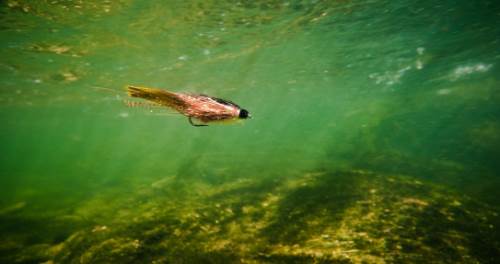
Light-colored hair baits also show very good results. Such “streamers” are rarely found on sale, but it is very easy to make yourself from a bunch of light synthetic fibers, a pair of feathers and a single or double hook with a long shank. It is best to start fishing for whirlpools from the highest point, so that the bait, when retrieving, is carried by the current to the beginning of the slope into the depths.
The bite most often occurs when the bait falls into the bottom depression (that is, the grayling “stands” on the slope itself).
If there is no bite when casting at the upper edge of the pool, the next casts are made lower and lower downstream. At the deepest point of the pool, bites are rare, and most often perch and pike grab the bait there. Grayling, as a rule, begins to be caught again at the exit from the pool.
The largest number of bites occur during a pause, but it is necessary to alternate the classic “step” with horizontal uniform wiring above the bottom - sometimes, for reasons unknown to me, grayling clearly prefers this kind of wiring. The grayling bite is sharp, “brazen”, reminiscent of a pike perch strike; it always swallows the bait deeply.
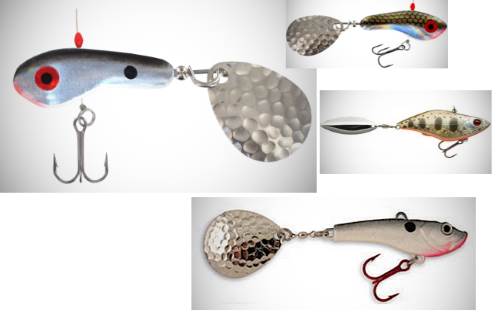
A good alternative to a soft bait with a “eared” sinker is a tail spinner. Its color is not decisive, but light-colored baits tend to get more bites. A tail spinner should be chosen with the smallest petal, but one that works (the petal should rotate and not oscillate - this is important), and the heaviest possible body.
The weight is preferably twenty percent heavier than that of a conventional jig head, which ensures high-quality wiring in these conditions. Why, in this case, are jig baits preferable to wobblers and spinners? The wobbler does not allow it to be “dumped” into the pool, so we cannot fish the most promising zone, but the usually used spinners do not reach the bottom in the pool - they are simply carried away.
Also interesting: Tench - what it eats and what it is caught with
On the fairway among the grass
The strip of water free from vegetation in the middle reaches of the Yuryuzan is about 5–10 m. In those areas where the current and depth allow you to enter the water, there is no point in fiddling with jig baits - just stand in the middle of the river and fish with heavy rotating spoons, moving them Wipp, Agat and other Myran spinners show excellent results ).
However, if you don’t have a wading suit (and you can’t survive more than 10 minutes in Yuryuzan without it) or the depth does not allow you to stand in an interesting fishing area, then you have to use non-snagging jig rigs. The main reason for using non-hooking baits is that, having cast into a strip of clear water on the fairway and made a 5-7-meter retrieve, you will have to drag the bait through 15 m of thick algae, which strives to “keep” your wobbler or spoon as a souvenir .
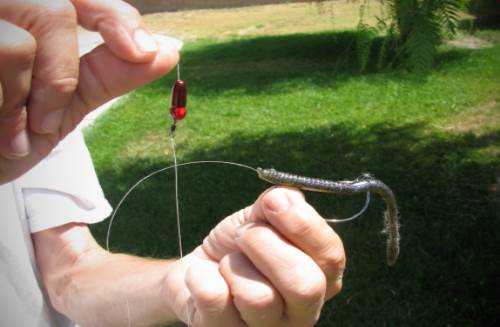
After trying various options, I finally settled on the Texas rig. Unlike the classic American version, we need heavy (at least 15-18 g) lead (not steel or brass) weights. You can now find already assembled bullet-shaped lead weights with an offset hook on sale. They will fit perfectly, you just need to choose the option with a heavy sinker and a small “offset” - size no more than 00 according to the international classification.
If you were unable to purchase something like that, don’t worry, you can use half or two-thirds of an “olive”, in the flat surface of which you need to make a hole with a regular drill - the hinge joint of the offset hook will go there. The hinge is more convenient than the sliding version, so it is optimal to use it.
Insert a piece of stainless wire into the ring of the offset hook, twist it a few turns, then insert it into the axial hole of the “olive” and form a small ring to which the fishing line will be attached.
It is best to use a medium-sized (70–80 mm) light-colored plastic worm with an active tail as bait. Bites also happen on larger baits, but the percentage of their sales is close to zero - the grayling is simply not detected. Even when using relatively large baits, catching one or two fish per dozen bites should be considered an excellent result.
The fishing technique is very simple
— cast across the current, trying to get the bait into the strip of weeds on the opposite side of the fairway (you shouldn’t cast far, just a couple of meters from the edge). Then they “pull” the bait through the grass and, as soon as it hits the edge of the clearing, they begin the slowest stepwise retrieve, trying not to lift the bait more than 30–35 cm from the bottom, that is, practically “drag” it along the bottom.
Also interesting: Catching ide with a float rod
Most often, bites occur when the bait comes out of the grass (at the first meter) and when it approaches the edge of the algae from the opposite side. I never had a bite in the middle of the fairway.
If there is no bite, and the bait has already entered the thickets of aquatic plants, it makes sense to jerk it to the surface and, holding the rod vertically, simply reel out the line as quickly as possible - there is no chance of grayling biting in the thick grass.
The bites are much less decisive than when fishing in pools, reminiscent of fine “crushing”. Until you get the hang of it, it’s better to hook on any suspicious push - otherwise, given the very low percentage of realization of even obvious bites, there is a chance of returning from the river empty.
You need to fish fairway nets very carefully, shifting each cast literally half a meter - often bites occur in areas located at a distance of about 1 m from each other. If you make wider casting steps, you can miss many potential bites.
A few subtleties
Grayling
is a very cautious and timid fish, so the tackle for catching it should be as inconspicuous as possible. It is not without interest that when fishing with rotating spoons and wobblers, grayling reacts very reluctantly to baits attached to “braid” of bright colors, giving a clear preference to transparent and thin monofilament.
When fishing with jig baits, grayling is much less picky in relation to fishing line - I caught it very well on FireLine in pink color - while new, it literally “glows” in the water, but the fish did not distinguish between it and monofilament fishing line. Well, in terms of sensitivity, naturally, braided line is better, especially when the grayling bites slowly and hesitantly.

The use of a metal leash, even the softest one, clearly has a negative effect on grayling fishing. And since a certain percentage of bites are pike, you have to put up with the loss of a certain amount of bait, since with a leash, grayling bites, which are already not particularly frequent, simply stop.
In conclusion, I would like to note that jig baits are not a panacea for grayling fishing, and, apparently, never will be. The algorithm proposed in this article operates only in certain conditions, when tried and true commonly used baits (wobblers, oscillating and rotating spoons) are “out of use.” I hope it helps you if you find yourself in a similar situation.
Category: Fishing
Lures in microjig
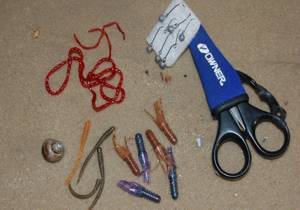
Tell us about the lures. Which one do you prefer when fishing? Why?
Sergey ( Spin23 ) is an active fisherman, member of the FRS NSO, winner of the amateur microjig fishing competition “Hell Microjig 2015”:
First of all, you need to decide what microjig is. For me it starts at 1 gram and ends at about four grams. At four grams light starts for me. The range of weights, as you can see, is very limited, and in this type of fishing every tenth gram plays its role. Light weight, very slow retrieval, small casting, in most cases fishing underfoot, and, as a rule, fishing with rather complex animation - all this leaves its mark on baits, which lately I have been using exclusively from edible plastic, with the right attractants.
I divide baits in any jig fishing into two large classes - active and passive baits. Most often, I use slicing baits as passive baits. Cutting, because I can form the necessary shape of the bait myself by cutting off or pinching off the excess from the silicone. As for slugs from factory manufacturers, such as Crazy Fish, Lucky John, sometimes it is enough to simply pinch off the active element from the bait. In some periods of time, the fish nibbles the bait precisely by the actively playing tail and does not try to swallow it further. After a little modification of the bait with your hands, you manage to seduce the fish. In the active class, I give my preference to twisters of classic shapes such as Crazy Fish Angri Spin, as well as vibrotails Russian Fishka Katyusha, Keitech Swing Impact, Reins Saturn micro.
There is another intermediate class of lures, I would call it krakozyabry, the lures seem to be passive, but some have elements that actively play on the retrieve. I really liked the Lucky John Hogy Hog in the smallest size.
Vitaly ( Vitaly69 ) is an active fisherman who has been practicing microjig fishing for several years:
Recently, having become interested in fishing with a spinning rod using a jig (I think that with the addition of silicone this is also part of the microjig), I use twisters and vibrating tails less and less often. I always carry edible silicone worms and slugs with me. Thanks to its shape with a weighted tail, the Aiko Fat Booty has a more catchy game on aggressive retrieves among slugs. The fish prefer bloodworms and maggots from Berkley to taste. These lures are used less by other spinners and, in my opinion, are more effective due to this. And their size and flavored additives ensure the capture of the largest number of fish species.
Microjig on the current
Usually I choose a straight section of the river with a constant flow, shallow depth near the shore and an edge at a distance of 5-15 m from the water's edge. More rarely, this is a broken coastline with bays where the current is either noticeably weaker than the channel one or is absent altogether. There are also riffles with strong rip currents. All of the options listed are ideal for microjig fishing. The current is weak and great, which means the fish are standing there, resting. A rebound jet is good, you can hope to see pike perch in the catch. Grass – there will be pike and perch. Fishing on a big river sometimes brings surprises in the form of asp, chub and, oddly enough, white fish: sabrefish, white bream, and silver bream. And this despite the fact that they are not caught with a jig.
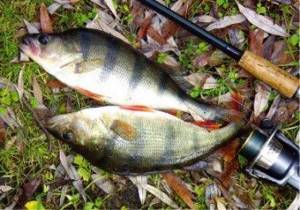
In the current, bait weights of at least 3-3.5 g are relevant for microjig. Cheburashka sinker with a collapsible eye. Owner Slim Offset hook or regular 59 series hook (also from Owner), size depends on the size of the bait. Large rivers do not always require the use of miniature baits. Here it is worth experimenting and on a 3.5 g Cheburashka it is quite possible to hang a bait measuring 3″-3.5″ (7.5-9 cm). Often this option brings a trophy. In general, the concept of a trophy in microjig is relative. When using microjig rods with a glued tip and 5-7 g of dough, a 300 g perch (and even in the current) is definitely a trophy, and a 1 kg pike is the fish of a lifetime.
Read: Catching crucian carp with microjig
First, we fish the coastline. We make the first casts upstream, parallel or almost parallel to the shore. In this case, when the line is stretched, the current instantly presses the bait and begins to drag it along the bottom. All that needs to be done is to give the bait a play with gentle tosses and pick up the slack of the “braid”. Sometimes it is useful to let the current drag the bait, which pike perch responds very well to. Next, we begin to gradually increase the casting angle, bringing it to 90° relative to the shore. Now, on the contrary, the current will slightly lift the bait on the stretched line. Therefore, it makes sense to increase the weight of the jig head to 4 g. Thus, the casting range will increase somewhat, which will allow you to fish the channel edge. It makes sense to change the wiring, perform double tosses or a classic jig: two or three turns of the reel - pause
The spinning rod for microjigging should be very sensitive, well absorb the jerks of the fish when playing. As a rule, such rods are not cheap and often belong to famous Japanese brands. It is easy to distinguish them from the general mass of fishing rods by their appearance - they all have an insert on the whip. A flexible carbon fiber insert is glued into the upper part of the second, thinner elbow for better registration of bites on rods with a tubular, that is, hollow, tip. In addition to microjigs, they allow you to fish with other baits - for example, UL class wobblers.
When choosing a fishing line, it makes sense to choose “braided”, which, due to its smaller diameter than monofilament, better resists the flow. Since the length of rods for microjigging is short (usually 200-230 cm), and you often want to cast further, you have to use the thinnest possible “braids”. You can use new eight-core cords, the only disadvantage of which is their high cost. I consider the NanoFill braided line from Bercley to be optimal in terms of price/quality ratio. For me, a cord with a diameter of 0.08 mm was ideal. which leads in casting distance. A fluorocarbon leash, approximately 1 m long, is desirable. The bait and part of the leash are subject to strong abrasive effects, especially when dragged over shell rock. Unfortunately, with this option, cuts are common when pike bites. However, as soon as you put in a metal leash - titanium, stranded steel or string - the number of bites drops sharply.
Read: Making a jig head
Of the silicone baits, the most catchy ones turned out to be fantasy ones (“creature”), imitating caterpillars, crustaceans, and shrimp. They have numerous legs, claws, double tails, etc. Thanks to this, the baits play interestingly when paused at the very bottom, and when dragging, they generally “blow the roof off” a large perch at that. Of these baits I’ll name Hog from Reins, new Aiko – Ribbed Worm, “rubber” or Lucky John – Hogy Hog, Rock Craw. It’s good if the rubber is also floating (for example, Hog has positive claw buoyancy). This must be taken into account when retrieving: during a pause, it is useful to simply move the bait slightly with the rod.
Of the worms, I think the most successful are the imakatsu Javastick and also the rubber from Crazy Fish - Polaris. With these baits, everything happens the other way around - the game is active, the pause is minimal. Although Javastick works great even when paused, since it floats and perfectly imitates either a leech or a worm wriggling at the bottom.
The presence of a boat provides the microjig fisher with enormous opportunities when fishing on rivers with strong currents. It is much more convenient to drop an anchor, for example, along the edge of the grass, and fish the coastal zone, or stand at the exit of the hole and, again, using up-stream casts, catch it only at a depth of more than 4 m, I recommend increasing the weight of the sinker to 5 g. When fishing in holes, like As a rule, in addition to perch, the catches contain pike perch, and sometimes quite large ones, and when you fish along the shore, along the grass, you come across perch and pike. Pike perch can also be caught near the shore at dusk, when it comes out to feed on the shallows. If you want to catch “white” fish, we reduce the mass of bait, you can also use a jig, placing scraps of “rubber” on the hook that imitate bloodworms.
Read: Catching pike with jerky
I note that microjig fishing on large rivers with strong currents does not immediately begin to bring results. On several fishing trips you will have to get used to fishing and frequent hooks. But when the technique is perfected, you will be able to surprise even your experienced spinning fishing neighbors.
Take care of the fish! Microjig is a catchy tackle, so keep only as much fish as you can eat. Let the little things grow up and do not remain indifferent to poaching.
Subscribe to
our Yandex channel Zen
Jig fishing
Microjig fishing technique

Tell us about the peculiarities of fishing when fishing with micro jigs. Are there any differences in fishing between microjig fishing for peaceful and predatory fish?
Sergey
As I said above, microjig fishing is quite slow fishing compared to heavier classes, but no less dynamic. The dynamics of fishing lie in the casting - on one cast you can use a lot of their varieties, from the classic jig step to jig fishing. But there are still two main techniques: dragging with throws above the bottom and the so-called double detonation of the bait from the bottom, simulating a sharp start of a fleeing fish or insect, which the predator cannot instinctively miss. Also, do not avoid long stops of the bait on the bottom with swaying and moving, imitating a swarming insect or worm. At the last event, I caught the fattest perch by stopping the bait on a vertical edge for a couple of seconds. This was enough for the perch to suck in Katyusha.
It was by stopping and dragging along the bottom that I caught the bulk of white fish, such as bream, crucian carp and ide.
Also, in suitable conditions, we should not forget about pelagic fishing - very often, not finding fish on the bottom, we leave the point, but if we just raise our fishing line a meter, we immediately get bite after bite.
Vitaly
The wiring depends on the design features of a particular spinning rod. It can be passive - pulling the spinning rod with slight movements (swings) of the tip and reeling out the slack of the cord, and aggressive - depending on the design features of a particular spinning rod, it can be micro jerks or shaking, with simultaneous winding of the reel, then a short pause and repetition. Passive wiring is more suitable for peaceful fish, while aggressive wiring is more suitable for predatory fish. Although a predator can react to any of them.
Line and cords in micro jig fishing
Date: March 3, 2015 | 720
Looking at the current variety of different fishing lines and cords on the market, it becomes difficult to choose. What should you wind on a spinning reel for microjig fishing? Cord or fishing line? Sunline, or maybe Berkley? Or even YGK? Or maybe Power Pro? Let's try to figure out what is better for microjigging than equipping your spinning rod. Not forgetting, of course, about the financial side of the issue.
So the conceptual question is: cord or line? The unequivocal answer, if you engage in microjigging seriously and closely, is the cord. The only justification for using a fishing line: “there is no money for a cord, there is no money yet...”. Fishing line is relatively, and sometimes significantly, cheaper than cord, and it is also used for microjigging. But this is only a necessary measure. Why is the cord so good? The first and main reason is high sensitivity due to the inextensibility of the cord and its special structure. The non-stretchable cord allows the angler to feel well everything that happens to the bait at the bottom: the slightest touch of algae, branches, bottom, the most subtle bites. Sometimes, you can even catch the fish moving its fins before attacking the bait (and this is not a joke). The ability to receive so much information about the condition of the bait is invaluable for microjigging, for conscious fishing, for progress and experimentation with wiring. This reason alone is enough to justify the total superiority of lines in microjig fishing. But, there are other positive aspects.
The cord obviously has greater strength than fishing line, with the same actual diameter. Of course, fishing lines are also developing and improving - many modern fishing lines are approaching the strength characteristics of cords, but the difference still remains. In addition, the lack of stretchability of the cord, coupled with strength, often makes it possible to save a caught bait.
The cord is softer than the fishing line - this increases the casting distance, especially if the surface of the cord is slippery and the cross-section is perfectly round.
Some of the advantages of cords also come with their disadvantages. So, inextensibility, in addition to sensitivity, also takes away such a factor as springing properties - and the cord does not help in any way to dampen the strong jerks of hooked fish. While the line stretches, taking on part of the jerk force. So, in the case of lines, the entire responsibility for successful fishing lies on the flexibility of the spinning rod, competent work with the reel brake, and, well, on the skill of the fisherman.
The cord is not as durable as fishing line. Its surface is softer, which means it is more easily damaged when in contact with driftwood and shell rock. There are cords that are positioned as wear-resistant. But, all the same, compared to fishing line, and even more so, with 100% fluorocarbon, their wear resistance leaves much to be desired. So, in places where the gear often comes into contact with shell rock at the bottom, with stones, you should use a fluorocarbon insert leash. A piece of fluor is extended onto the cord using special knots and protects the tackle in the most critical segment, the outermost 1-2 meters from the bait.
Also, the disadvantages of cords include the fact that they are usually more visible in the water than transparent fishing line. If this is critical, the water is clear, and the fish is cautious, then they also rely on a fluorocarbon insert between the bait and the line, because the flurry is almost invisible in the water.
Now let's talk about the different types of cords, and which ones are best suited for microjig fishing.
Cords, conditionally, of the first generation visually resemble thread, fibers, etc. are clearly visible there. Good examples: Power Pro, Salmo Elite Braid, Sunline PE. As a rule, these cords do not have a perfectly round cross-section and are not very slippery. Their actual diameter is always higher than stated; they tend to gradually increase in diameter during fishing. Such cords are good for medium and heavy jigs, for fishing with spoons and wobblers. But it is the thin versions 0.06mm, 0.08mm, 0.1mm that are not very suitable for microjig fishing. They give an extremely lousy casting range, they are too thick, in fact, even though the stated diameters seem to be just right. For fishing with silicone baits, edible baits, using small weights, we need a thin cord, soft, with a slippery coating. It is he who will give us a good casting range and proper sensitivity. There are such cords - for example, Sunline Small Game PE, Varivas Light Game Mebaru, YGK G-Soul PE, Climax miG. You can also look for products of a similar level on the market; new brands and cords are constantly popping up (Japanese brands are gradually coming to our open spaces :)).
These cords have all the necessary properties: round cross-section, slippery surface, small diameters, tight weaving, they wind perfectly, and with a high-quality reel they do not create any problems with dropping loops. These, of course, are not ropes that can be used to uproot snags to save bait - thin cords are not designed for this. These products have only one most striking drawback - their prices are simply indecent (maybe only with the exception of miG). If finances allow, you can take Small Game, Light Game or something similar.

There are also cords that, it seems, are not cords at all, but some kind of thread made of sintered nanofibers with a special coating - Berkley Nanofil and the like. Considering the options for equipping my microjigging gear, Nanofil caught my attention and I tested it. The cord is perfectly round and has a very slippery coating. It seems like a fishing line, but Nanofil is much softer. It is non-stretchable, which gives the desired sensitivity. Nanofil is presented in a wide range of diameters, down to ultra-small ones - 0.02, 0.04, 0.06, etc. ascending. The cord is very strong for its diameter. I even unbent, from time to time, small Overner hooks.
Advantages of nanofil: fantastic reach, sensitivity, durability and a reasonable price. Cons: capriciousness on the nodes and poor wear resistance. It was necessary to settle down with the knots. You seem to be knitting as usual. One knot comes out wonderful, it holds - super. The other one breaks like a cobweb... I settled down, began to knit knots more intently, paying attention to the uniformity of the turns, their non-intersection - and the problem went away. As for damage to the surface of Nanofil upon contact with driftwood and algae, this exists. The surface of the cord gradually frays, and what appears to be fluff appears - fragments of the coating. If you let it get too frayed, the cord weakens and breaks more easily. First, I regularly inspect the end section of the cord and cut off what is damaged. Secondly, using a leader made of 100% fluorocarbon, 1-1.5 m long, significantly reduces this problem, because It’s already rubbing against everything on the bottom, not the cord – but the fluorocarbon, which is very good as an anti-abrasive leash.
So, if your budget doesn’t stretch to cool ultralight Japanese cords, then it makes sense to pay attention to Nanofil and other second-generation cords with a small diameter.
Line for microjig fishing , as mentioned at the beginning, is not the best choice. It does not provide the same sensitivity and control over the bait. The fishing line is stiffer than the cord, and this significantly reduces the casting distance of the bait using it. But, the fishing line stretches and absorbs the jerks of the fish being caught, and is also inexpensive. If money is really tight and you don’t have enough money for a cord, then you need to take a high-quality thin fishing line. Good examples are Owner Broad, Gamakatsu Super G-Line, Balsax Iguana. The optimal monofilament diameter for microjigging is 0.08-0.14mm, sometimes up to 0.16mm.
The question may arise: why not just use solid fluorocarbon as the main line in microjigging, since it is so wonderful, wear-resistant and inconspicuous? In addition, it has little stretch... The problem is that the fly is even stiffer than the fishing line - and you can’t cast far with it. If you fish in very small bodies of water, please try it.
Share with your friends:
Categories: Tackle · Tags: Line, Microjig, Tackle, Spinning, Fluorocarbon, Cord
Cord or fishing line?
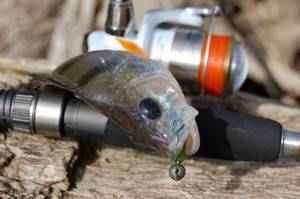
Choice of fishing line. Braided or monofilament, what is the diameter? Which type do you prefer and why?
Sergey
The fishing line directly depends on the fishing conditions; as a rule, in my arsenal there is a very thin braided line according to the Japanese classification 02 or 03, for example Sunline Rock Fish PE. And also two forests of different diameters, a thinner one, for example, 0.10 and a thicker one, 0.14. A very important component is to achieve the optimal ratio of the arc of the fishing line and the time the bait falls, as well as how much control you have over the process. At some moments we will need an instant hook at the slightest contact with the fish, at others, on the contrary, we need to “disconnect” from fishing and let the passive fish chew the bait. Fluorescent leashes are required when fishing with braided line.
By the thickness of the leash we can further regulate the hanging time of the bait.
Vitaly
I always use 0.12 monofilament line. This is due to the fact that my main target for fishing with a jig is peaceful fish, and on a hard cord its lips will simply tear. Also on light weights, when using a cord, the wind causes many problems, both when casting and when animating a light bait.

